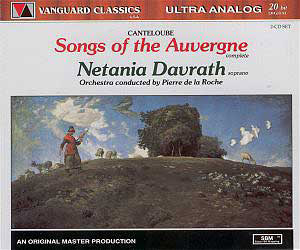These two discs remain the reference against which all other
recordings are measured.
Netania Davrath (1931-1987) grew up with Russian and
then Israeli folksong in her artistic veins. This may well account for
her avoidance in this context of operatic convention which in other
throats so often suffocates these green-fresh songs. There was a time
when every operatic diva, actual or presumptive, of the seventies seemed
to grasp a selection of the Auvergne songs and stamp their identity
into and on them. While de Los Angeles, von Stade, Bayo and Gomez have
their moments Davrath stands supreme in any company.
The Auvergne songs, first performed in 1924 at the
Concerts Colonne in Paris, are in local dialect. Davrath, fluent in
eight languages, had six months of study with a language coach to secure
an authentic approach to pronunciation. The New Songs are in
straightforward French. Sung texts and translations appear side by side
in the Vanguard booklet.
Davrath was not the first to record these Songs. She
was preceded by the great Madeleine Grey and the eleven she recorded
in 1930 with Elie Cohen are to be had on Pearl GEM0013. Grey is valuable
and it was her 78s through which I came to know the songs when they
were broadcast on BBC Radio 3 in the early 1970s. Grey only recorded
a double handful while Davrath recorded all five series - 27 songs (and
they are all here). She then added fifteen others which are here called
New Songs of the Auvergne. These New Songs are largely
from collections of folksongs from other French regions: Chants-paysans-Auvergne
et Quercy; Chants paysans-Quercy; Chants Paysans-Bearn;
Chants du Languedoc; Chants des Pays-Basques (part recorded
on Naïve by Maria Bayo who comes closest to the Davrath approach).
Canteloube showed a very sure hand when arranging and
orchestrating these gems. His skill bears comparison with Grainger's
without bring quite so oddball. Certainly when you compare Grainger's
handle on Shallow Brown and Brigg Fair with Canteloube's
dissections and reconstructions the same genius is at hand. The trick
which both composers pull off while using classical apparatus is not
to stifle the butterfly, birdsong, mist, escarpments, sun-dazzle, sheep
calls and heat-haze of the originals. Canteloube works with an impressionistic
palette, making the subtlest intensifying use of piano figures, flute,
oboe and clarinet voicings. The lovely balance and touch of the instrumental
gauze takes the lightest tincture from Ravel, d'Indy (Symphonie Cévennole),
Roussel (Poème de la Forêt) and Bonnal. Who is Pierre
de la Roche and why is the orchestra unnamed? Can anyone shed light
on this?
Davrath's voice has a lambent girlish quality which
takes you to a land which has some parallels with the scenes of the
novels of Marcel Pagnol (Manon des Sources). She is free from
that modern and stultifying sine qua non of the 'great' soprano
- vibrato. Her vocal production is pure but infused with warm feeling,
endearment, affection, humour and sensuousness. She is elegant without
gentility; folk-like, pristine and flamboyant.
The tracks to sample are numerous. There is the trilling
L'aïo dè rotso, Chut, Chut and the melting
sweetness of Lo fiolaire. The heat haze shimmers in Obal,
din lo coumbèlo, Pastorale, Baïlèro,
Jou l'pount d'o Mirabel and Pastourello. Brilliance and
glory in the sun thrill through L'Antouèno and Lou
diziou bé. There is a knowing cheeky wink in Hé!
Beyla-z-y d'au fé! (with its donkey brays), Pastrouletta,
Lou Coucut (with a lubricious cuckoo that would have been unrecognised
by Delius's First Cuckoo) and in Malurous qu'o uno fenno.
Oï ayaï swoons in Delian sympathy before developing
a Gascon swagger. A sing-song comfort reminisces its way through Quand
z'eyro petitoune. The zip and vocal bravura of the dog calls in
Tè l'co tè! are not to be missed.
In the New Songs Davrath frequently darkens
her voice and takes on a new persona - less the demoiselle bergère;
more the diva; though always steering clear of grand opera suffocation
that would flatten these blooms. These songs are not as fine as the
five Auvergne sets though Moi j'ai un homme has some of that
delightful coquettish playfulness. The Kingsley orchestrations are more
treacly than those of Canteloube although Allons, beau rossignol
is pretty close and the Delian awakening of Reveillez-vous, belle
endormie makes for a lovely effect.
Having bought the double LP set on VSD (gatefold sleeve)
in circa 1978 I hurried, in the dawn of the CD, to buy a silver disc
equivalent. My enthusiasm resulted in my buying two prohibitively expensive
Japanese imports on King Vanguard CD K33Y 151 and 152 each sprinkled
with Japanese characters and marked ¥3,300. They cost me in total £32.00
and that was in about 1986! I still have those discs. They are laid
out differently than these two Vanguards with the fourth song-set split
3:3 across the two discs.
The current Vanguard set (which can also be had in
SACD format) is in AAD, ultra analog, 20 bit digital sound and
sounds superb not once flinching under the stratospheric demands and
pure searching poignancy of Davrath's irreplaceable voice. The original
30ips half inch master tapes were made on an Ampex 300 series vacuum
tube (valve) tape recorder. Specially designed playback heads were used
and greatest attention paid to alignment, signal to noise ratio and
frequency response. The results are there for all to judge and revel
in.
Intriguingly the New Songs (which are miscalled
as New Songs of the Auvergne - only one of them is from the Auvergne)
sound different suggesting not only Gershon Kingsley's orchestrations
rather than Canteloube's but also a different venue and/or microphone
placement.
Rob Barnett


![]() See
what else is on offer
See
what else is on offer 